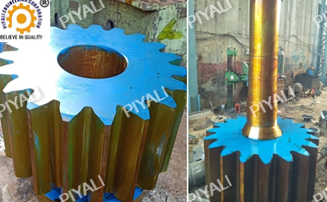Piyali Group Corporation is the proud designer and manufacturer of high-quality 100 TPD cooler pinion assembly products that acknowledges as some of the best in the sector. Our products perform a variety of functions in many factories and industries. The cooler pinion assembly is a component of a rotary kiln’s cooling mechanism used in the manufacturing of sponge iron or steel. Automotive, Industrial, robotics applications and consumer goods are just a few of the industries that frequently use pinion gear assemblies. Proper maintenance and inspection is necessary for the cooler pinion to operate safely and efficiently.
The pinion assembly is a mechanical component which helps in the rotation of the cooler shell, which is an essential part of the rotary kiln’s cooling process. The 100 TPD cooler pinion assembly consists of various parts such as pinion, cooler pinion with shaft, kiln pinion with plummer block, end plates or end covers.

COOLER PINION ASSEMBLY PARTS:
STEP 1: PINION GEAR
PIYALI GROUP manufactures, supplies, and exports high-quality pinion gear also known as cylindrical gear that rotates the cooler shell by meshing with the spur gear. Pinion gears are essential parts in several industrial applications, and their design and production requires knowledge and reliability to guarantee stable and effective performance. It usually consists of high-quality steel and carefully machined to ensure proper fit and function. An essential component of the 100 TPD cooler pinion assembly in a DRI sponge iron plant is the pinion gear. A pinion gear is a small(pinion) gear that meshes with a larger(girth) gear and work in pairs to transfer and adjust rotary motion and power.
STEP 2: PINION SHAFT
A shaft is a long cylindrical rod that transmits power or motion from one portion of a machine to another. The pinion shaft is a cylindrical shaft that holds the pinion gear in place and transfers torque from the gear to the cooler shell. It typically consists of high-strength alloy steel and aims to endure rotational and heavy load stresses. The shaft is the main part of the 100 TPD cooler pinion assembly.

To ensure proper operation and durability, both pinion gear and pinion shaft must be carefully manufactured and designed according to exact specifications. It involves careful material selection, precision machining, and rigorous testing to ensure that the components are able to endure the stresses and conditions of the rotary kiln system.
STEP 3: PLUMMER BLOCK
A Plummer block, also known as a pillow block bearing, is a form of bearing housing used to support a rotating shaft. A bearing that supports the rotating shaft is located inside the housing. For the purpose of lubricating or maintaining the bearing, the plummer block features a removable end cap or cover. They provide an easy and effective method for maintaining spinning shafts while avoiding noise and vibration. The shape and dimensions of the plummer block determines by the size, speed, and weight of the shaft, as well as by the application’s environmental circumstances.
COOLER PINON ASSEMBLY FOR DRI SPONGE IRON PLANTS:
- Pinion gear
- Cooler Pinion with Shaft
- Cooler Pinion with Plummer Block (Bearing house assembly)
- End Plates & End Covers
1. PINION GEAR:
A pinion gear is a part of 100 TPD cooler pinion assembly used in several manufacturing processes, including the production of cement,mineral processing, creation of chemicals, and the production of an iron ore (Iron ore pellets and other materials. This is a small gear with fewer teeth than the larger gear it meshes with, called the “ring gear”. The purpose of the cooler pinion is to transfer power from the kiln drive system to the rotating kiln shell, which supports two or more rollers. A rotating gear meshes with a pinion, typically consists of cast or forged steel, with a diameter around the teeth.
The main purpose and function of pinion gear is to convert the rotational motion of the drive shaft into the rotational motion required by the ring gear. The pinion gear in a cooler pinion assembly is usually smaller in diameter than the ring gear, allowing for a gear reduction. Gear reduction reduces gear reduction to provide more torque to the wheels and axles to move the vehicle.
100 TPD Cooler Pinion Gear Technical Specifications
- MODULES – 40 Module
- CAPACITY – 100 TPD Rotary Cooler Pinions for Sponge Iron Steel Plant
- CERTIFICATION – ISO9001
- No of Teeth – 19
- MATERIAL GRADE – IS-2708 GRADE II, IS-2644 GRADE II, EN-19, EN-24 FORGED
- DESIGN – AS PER CUSTOMER PROVIDED (POPURI / IPS / ITC / MEC / LURGI etc.)
FEATURES OF PINION GEAR:
- The pinion gear is essential for efficient power transmission and smooth operation.
- Pinion gears are generally cylindrical in form and their teeth cut into the circumference of the gear.
- Simpler in design and excellent customer service support.
- The pinion gear transmits power from the drive shaft to the ring gear, which turns the wheels.
- Proper lubrication is a necessity for pinion gears to prevent wear and damage from friction.
- Small and light in weight.
2. PINION SHAFT:
An essential part of the rotary cooler device is the pinion shaft. The pinion shaft is a cylindrical shaft that holds the pinion gear in place and transfers torque from the gear to the cooler shell. This improves the shaft’s strength and, as a result, its capacity to withstand the significant torque. With the help of coupling, it transfers the force that the motor produces to the rotary cooler, which rotates the material inside. A pinion gear, a shaft, and bearings usually make up the pinion shaft. The shaft is the main part of the 100 TPD cooler pinion assembly.
PINION SHAFT KEY:
A shaft key is a tiny, rectangular piece of metal that fits into a keyholes or slot on the shaft. The key transmits the force from the shaft to the driven part, such as a gear or a pinion, as the pinion shaft rotates. In order to lock the key in position, the retaining nut or bolt must be tightened into the keyway on the shaft and gear. The key is essential in transferring torque from the pinion gear to the shaft, which enables the gear to spin and power additional parts like a differential or transmission. Without a correctly fitted key, the gear may slip or become out of alignment, which could impair performance or harm the engine. In rotary kilns, pinion shaft keys secure the pinion shaft to the kiln shell and enable movement of the kiln.
PINION SHAFT GEAR COUPLINGS:
Pinion shaft gear couplings are mechanical parts that join the pinion shaft of a motor or engine to other moving parts, like a gearbox or transmission. The coupling is made up of two halves, each with internal teeth that mesh with the exterior teeth of the pinion shaft and the other rotating component. Pinion shaft gear couplings are made to transfer torque between the parts while adjusting for any rotation or misalignment. The gear teeth offer a solid connection that enables the transfer of power without slippage or loss of effectiveness.
WORKING:
A pinion shaft gear coupling is usually installed by attaching one half to the pinion shaft and the other to the driven shaft. Coupling is used to correct misalignment in machinery. The teeth then mesh to form a connection as the two halves are pulled together. Coupling enables rotation of two axles while correcting for possible misalignment.
100 TPD Cooler Pinion Shaft Technical Specifications
- MODULES – 40 Module
- CAPACITY – 100 TPD Rotary Cooler Pinion Shafts for Sponge Iron Steel Plant
- CERTIFICATION – ISO9001
- No of Teeth – 19
- MATERIAL GRADE – IS-2708 GRADE II, IS-2644 GRADE II, EN-19, EN-24 FORGED
- DESIGN – AS PER CUSTOMER PROVIDED (POPURI / IPS / ITC / MEC / LURGI etc.)
FEATURES OF PINION SHAFT:
- Pinion gear shafts transmits torque more efficiently than other types of shafts, which reduces frictional losses.
- Pinion shafts transmit power over long distances without significant power loss.
- Pinion shafts endure higher loads and stresses, which makes them more durable and reliable than other types of shafts.
- Pinning shafts are extremely versatile and can be used in a variety of applications, from automotive to industrial machinery.
- Pinion shafts are easy to maintain and repair
3. PLUMMER BLOCK:
A plummer block, also known as a pillow block or bearing housing. This is a component used in a cooler pinion assembly to hold a rotating shaft. The main function is to provide a secure and stable mounting point for the shaft,. This allows smooth and efficient rotation of the pinion gear.

100 TPD Cooler Plummer Block Technical Specifications
- MODULES – 40 Module
- CAPACITY – 100 TPD Rotary Cooler Plummer Block for Sponge Iron Steel Plant
- CERTIFICATION – ISO9001
- MATERIAL GRADE – IS-2708 GRADE II, IS-2644 GRADE II, EN-19, EN-24 FORGED
- DESIGN – AS PER CUSTOMER PROVIDED (POPURI / IPS / ITC / MEC / LURGI etc.)
FUNCTION AND PURPOSE OF PLUMMER BLOCK:
- The plummer block in a cooler pinion assembly is usually situated at the end of the pinion shaft, where it connects to the drive shaft.
- The plummer block aims to support the shaft and pinion gear while also serving as a bearing surface for the shaft to rotate on.
- This bearing surface reduces friction and wear on the shaft and pinion gear, which can help to extend their lifespan and enhance assembly efficiency.
- The plummer block also helps in the removal of heat produced during operation.
- Cooling fans increase surface area and heat transfer which helps to boost surface area and enhance heat transfer.
FEATURES OF PLUMMER BLOCK:
- HOUSING: Plummer block assembly provides stable mounting surface for bearing.
- PEDESTAL: The pedestal (base), usually made of cast iron or steel. The pedestal provides a secure and stable base for the bearing.
- END CAP: An end cap in a plummer block is a small metal cover that seals and protects the leading edge of the pinion shaft in a plummer block assembly. The end cover helps maintain the lubricant in the housing of the bearing.
- BEARING: The bearing is a component that enables a shaft to rotate smoothly. The bearing is mounted inside the housing, which protects it from pollution and guarantees proper lubrication.
- MOUNTING SYSTEM: The mounting system secures the bearing to the pedestal. It usually contains a set screws or secure cap that hold the bearing firmly in position and prevent it from rotating within the housing.

